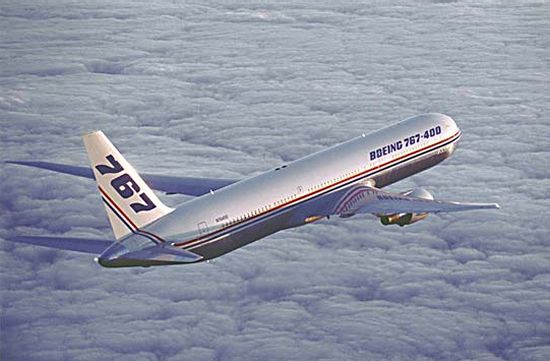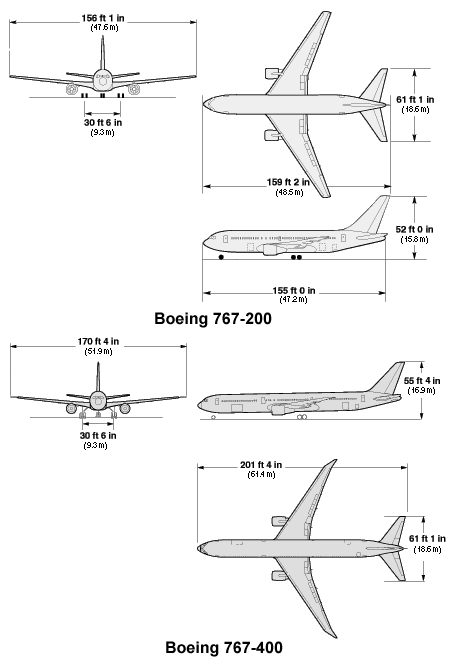|
||||||||||
|
|
||||||||||
|
||||||||||
|
|
||||||||||
 - -
|
|

|
Boeing 767 Medium to Long-Range Jetliner |
|
DESCRIPTION:
Boeing announced both the 757 and 767 projects in 1978. These two aircraft were introduced to incorporate the latest technological innovations in airliner design. While the 757 was built as a narrowbody replacement for the 727, the 767 is a widebody intended to compete with the rival Airbus A310. Both the 757 and 767 programs benefitted from shared development efforts and the use of computer aided design (CAD) tools that offered significant savings in cost and time. Much of the wing structure and many of the high-lift devices are common to both designs, although the 767 utilizes a wing of greater span, sweep, and chord to provide much greater wing area. The two aircraft also share the same engines, except those used on the 767 are uprated for greater thrust. In addition, both aircraft share the same two-crew flight deck and most avionics systems allowing pilots to be trained to operate either plane. Several variants have entered service, including the 767-200, stretched 767-300 and 767-400, extended range models, and the 767-300F dedicated cargo version. The 767-400 series features a new wing of increased span with new wingtips optimized for long-range flight. With military versions of the 707 reaching the end of their service life, Boeing has also begun offering tanker, airborne early warning, battlefield surveillance, and electronic reconnaissance variants based on the 767. The E-767 AWACS model has entered service with Japan while both Japan and Italy have purchased a combination transport and tanker variant. US Air Force plans to lease 100 767 tanker variants for ten years were cancelled after revelations of corruption in the contract award process, but the KC-767 remains a strong contender for an Air Force tanker order. Including all models, about 835 examples of the 767 were built by 2001. New orders slowed in the early 21st century leading to speculation that the production line may be closed down, particularly if the US Air Force does not order a tanker variant. Order levels improved, however, though the 767 line will eventually be replaced by the Boeing 787.
Data below for 767-200, 767-300, and 767-400ER |
|
| HISTORY: | |
| First Flight |
(767-200) 26 September 1981 (767-200ER) 6 March 1984 (767-300) 30 January 1986 (767-300ER) 9 December 1986 (767-300F) 20 June 1995 (767-400ER) 9 October 1999 |
|
Service Entry
|
(767-200) 8 September 1982 (with United Airlines) (767-200ER) 27 March 1984 (with El Al Israel Airlines) (767-300) 20 October 1986 (with Japan Airlines) (767-300ER) 3 March 1988 (with American Airlines) (767-300F) 16 October 1995 (with United Parcel Service) (767-400ER) 14 September 2000 (with Continental Airlines) |
| CREW: |
two or three flight crew: pilot, co-pilot, flight engineer (early production models only)
|
| PASSENGERS: |
(767-200) 181 in three classes, 224 in two classes, 255 in one class (767-300) 218 in three classes, 269 in two classes, 351 in one class (767-400ER) 245 in three classes, 304 in two classes, 375 in one class |
|
ESTIMATED COST:
|
(767-300ER) $115.5 to $127.5 million [2002$] (767-400ER) $154 to $169 million [2007$] |
| AIRFOIL SECTIONS: | |
| Wing Root | unknown |
|
Wing Tip
|
unknown
|
| DIMENSIONS: | |
| Length |
(767-200) 159.17 ft (48.51 m) (767-300) 201.33 ft (54.99 m) (767-400ER) 242.33 ft (61.42 m) |
| Wingspan |
(767-200) 156.08 ft (47.57 m) (767-300) 156.08 ft (47.57 m) (767-400ER) 170.33 ft (51.97 m) |
| Height |
(767-200) 52.00 ft (15.85 m) (767-300) 52.00 ft (15.85 m) (767-400ER) 55.33 ft (16.88 m) |
| Wing Area | (767-200) 3,050 ft² (283.35 m²) |
|
Canard Area
|
not applicable
|
| WEIGHTS: | |
| Empty |
(767-200) 179,080 lb (81,230 kg) (767-300) 191,700 lb (86,955 kg) (767-400ER) 227,300 lb (103,100 kg) |
| Normal Takeoff | unknown |
| Max Takeoff |
(767-200) 395,000 lb (179,170 kg) (767-300) 412,000 lb (186,880 kg) (767-400ER) 450,000 lb (204,120 kg) |
| Fuel Capacity | 23,980 gal (90,770 L) |
|
Max Payload
|
(767-300F) 135,520 lbs (61,470 kg)
|
| PROPULSION: | |
| Powerplant |
(767-200) two Pratt & Whitney PW4062 turbofans or two General Electric CF6-80C2B7F turbofans (767-300) two Pratt & Whitney PW4062 turbofans or two Rolls-Royce RB211-524H turbofans or two General Electric CF6-80C2B7F turbofans (767-400ER) two Pratt & Whitney PW4062 turbofans or two General Electric CF6-80C2B8F turbofans |
| Thrust |
(PW4062) 126,600 lb (563.2 kN) (CF6-80C2B7F) 124,200 lb (552.5 kN) (CF6-80C2B8F) 127,000 lb (564.9 kN) (RB211-524H) 119,000 lb (529.4 kN) |
| PERFORMANCE: | |
| Max Level Speed |
at altitude: unknown at sea level: unknown cruise speed: 530 mph (850 km/h) at 35,000 ft (10,675 m), Mach 0.80 |
| Initial Climb Rate | unknown |
| Service Ceiling | 39,000 ft (11,885 m) |
| Range |
(767-200) 6,610 nm (12,250 km) (767-300) 6,110 nm (11,320 km) (767-300F) 3,265 nm (6,055 km) (767-400ER) 5,635 nm (10,440 km) |
| g-Limits |
unknown
|
| KNOWN VARIANTS: | |
| 7X7 | Original designation for the 767 |
| 767-100 | Originally planned shortended model for 180 passengers; cancelled |
| 767-200 | First production model; 238 built by 2001 |
| 767-200ER | Extended range model based on the 767-200 with increased and maximum takeoff weight and fuel capacity for long-range flight |
| 767-200C | Prototype of the original KC-767A refueling tanker based on the 767-200ER but including the flight deck of the 767-400ER, modified flaps, strengthened landing gear, and improved electrical generators |
| 767-200LRXF | Long-range freighter variant based on the 767-200C |
| 767-300 | Stretched model with a lengthened fuselage for greater passenger capacity; 576 built by 2001 |
| 767-300ER | Extended range model based on the 767-300 with increased maximum takeoff weight and fuel capacity for long-range flight |
| 767-300F | Cargo freighter based on the 767-300 |
| 767-300BCF | Boeing Converted Freighter, former 767-300 passenger models converted into cargo transports |
| 767-400 | Next generation 767 model incorporating new raked wing tips for long-range flights and more advanced avionics; 21 built by 2001 |
| 767-400ER | Extended range 767-400 model with a lengthened fuselage, raked wingtip extensions, and strengthened landing gear |
| E-767 | Military airborne warning and control system (AWACS) version based on the 767 airframe, operated by Japan |
| B-767 or E-767T-T | Combination military transport and tanker based on the 767-200ER with some features of the -300 and -400ER and equipped with a fuselage refueling boom as well as two underwing refueing pods, ordered by Italy and Japan |
| KC-767 |
Proposal for a refueling tanker based on the 767-200LRXF offered to the US Air Force
|
| KNOWN OPERATORS: | |
| Civil |
Abu Dhabi Amiri Flight ABX Air Aeris Aero Continente Chile Aero Continente Peru Aer Lingus Aeroflot Aéromaritime Aeromexico Aerovias Air 2000 Air Afrique Air Algerie Air Aruba Air Atlanta Icelandic Airborne Express Air Canada Air China Air Europa Air Europe Air France Air Gabon Air Holland Air India Air Japan Air Luxor Air Madagascar Air Maurtius Air New Zealand Air Niugini Air Pacific Air Philippines Air Seychelles Airtours International Air Transport Service Group (ATSG) Air Zimbabwe Alitalia ALLEX All Nippon Airways (ANA) American Airlines Amerijet International ANA Cargo Ansett Australia Ansett Worldwide Asiana Airlines Atlantic Coast Airlines Avianca Azerbaijan Airlines AWAS Aviation Services Balair Balkan Bulgarian Airlines Bellview Airline Britannia Airways British Airways Cameroon Airlines Canadian Cargojet China Southern Chuna Yunnan Airlines City Bird Condor Airlines Continental Airlines Corsair Delta Air Lines DHL East African Airlines Egypt Air El Al Israel Airlines Eritrean Airlines Ethiopian Airlines Eurofly Eva Air Excel Airways First Choice Garuda Indonesia Genesis Lease GMG Airlines Gulf Air Hainan Airlines Hawaiian Airlines Hokkaido International Airlines Iberia International Lease Finance Corporation (ILFC) Japan Airlines Japan Asia Airlines Kenya Airways KLM - Royal Dutch Airlines Kras Air Kuwait Airways LAM - Mozambique Lan Chile Lan Ecuador LAPA Lauda Air Lignes Aériennes Congolaises (LAC) Lot LTU International Airways Malev Hungarian Airlines Martinair MAXjet Mid East Jet Monarch Nationwide Airlines North American Airlines Qantas Regionair Royal Brunei Airlines Royal Nepal Airlines SAS Scandinavian Airlines Shanghai Airlines Skymark Airlines Sobelair South African Airways Spanair Swiss World Airlines TACA International Airlines Tampa Cargo Airlines Tradecraft Airlines Transaero Transbrasil Trans World Airlines (TWA) TUI Ukraine Airlines United Airlines United Parcel Service (UPS) US Airways Uzbekistan Airways Varig Brasil Vietnam Airlines XL Airways Zoom Airlines |
| Government/Military |
China, Zhongkuo Shenmin Taifang Tsunputai (People's Liberation Army Air Force) Italy, Aeronautica Militare Italiana (Italian Air Force) Japan, Nihon Koku-Jieitai (Japan Air Self Defence Force) |
|
3-VIEW SCHEMATIC:

|
|
SOURCES:
|
|


|
Aircraft | Design | Ask Us | Shop | Search |

|
|
| About Us | Contact Us | Copyright © 1997-2023 | |||
|
|
|||